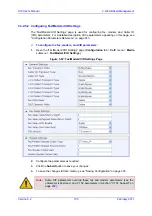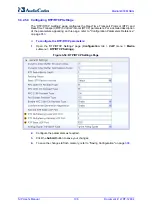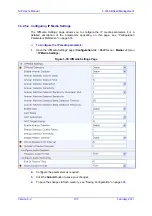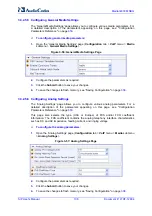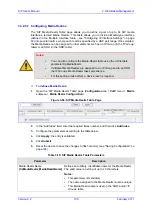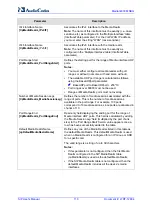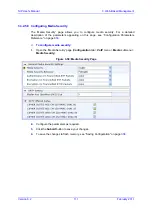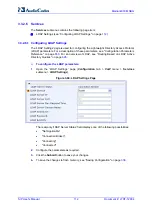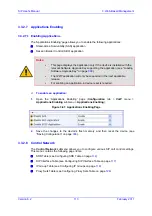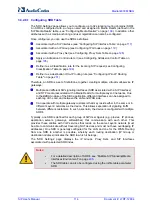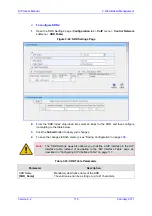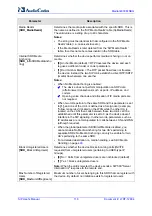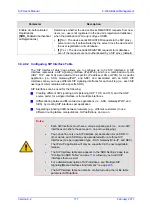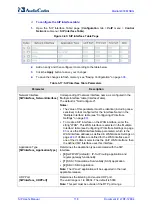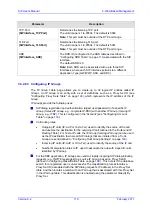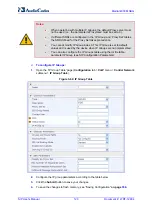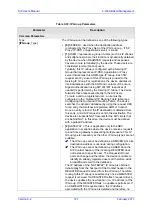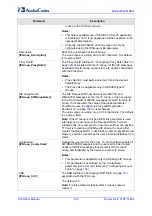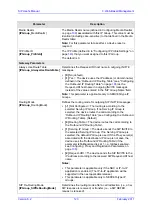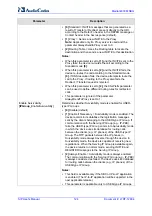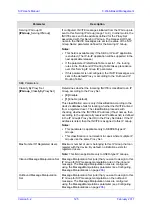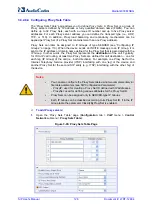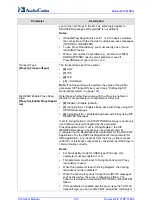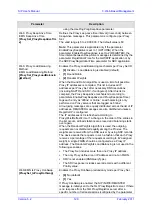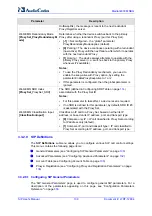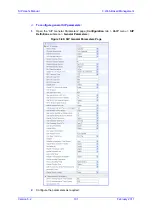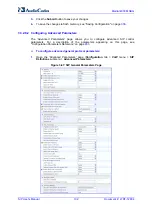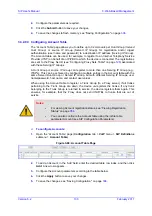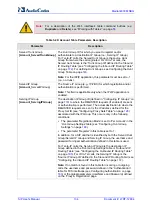
Version 6.2
119
February 2011
SIP User's Manual
3. Web-Based Management
Parameter
Description
TCP Port
[SIPInterface_TCPPort]
Determines the listening TCP port.
The valid range is 1 to 65534. The default is 5060.
Note:
This port must be outside of the RTP port range.
TLS Port
[SIPInterface_TLSPort]
Determines the listening TLS port.
The valid range is 1 to 65534. The default is 5061.
Note:
This port must be outside of the RTP port range.
SRD
[SIPInterface_SRD]
The SRD ID (configured in the SRD table as described in
''Configuring SRD Table'' on page
) associated with the SIP
Interface.
The default SRD is 0.
Note:
Each SRD can be associated with up to three SIP
Interfaces, where each SIP Interface pertains to a different
Application Type (GW/IP2IP, SAS, and SBC).
3.3.2.8.3 Configuring IP Groups
The 'IP Group Table' page allows you to create up to 32 logical IP entities called
IP
Groups
. An IP Group is an entity with a set of definitions such as a Proxy Set ID (see
''Configuring Proxy Sets Table'' on page
), which represents the IP address of the IP
Group.
IP Groups provide the following uses:
SIP dialog registration and authentication (digest user/password) of a specific IP
Group (
Served
IP Group, e.g., corporate IP-PBX) with another IP Group (
Serving
IP
Group, e.g., ITSP). This is configured in the 'Account' (see ''Configuring Account
Table'' on page
Call routing rules:
•
Outgoing IP calls (IP-to-IP or Tel-to-Tel): used to identify the source of the call
and used as the destination for the outgoing IP call (defined in the 'Outbound IP
Routing Table'). For Tel-to-IP calls, the IP Group (
Serving IP Group
) can be used
as the IP destination to where all SIP dialogs that are initiated from a Trunk
Group are sent (defined in ''Configuring Hunt Group Settings'' on page
•
Incoming IP calls (IP-to-IP or IP-to-Tel): used to identify the source of the IP call
•
Number Manipulation rules to IP: used to associate the rule with a specific calls
identified by IP Group
For the SBC application, IP Groups are used to classify incoming SIP dialog-initiating
requests (e.g., INVITE messages) to a source IP Group, based on Proxy Set ID
(defined in Configuring Classification Table on page
). This occurs if the database
search for a registered user is unsuccessful. The classification process locates a
Proxy Set ID (associated with the SIP dialog request’s IP address) in the Proxy Set
table, and then locates a match with an IP Group that is associated with this Proxy Set
in the IP Group table. This classification is enabled using the parameter Classify By
Proxy Set.
Summary of Contents for Mediant 800 MSBG
Page 2: ......
Page 366: ...SIP User s Manual 366 Document LTRT 12804 Mediant 800 MSBG Reader s Notes ...
Page 372: ...SIP User s Manual 372 Document LTRT 12804 Mediant 800 MSBG Reader s Notes ...
Page 390: ...SIP User s Manual 390 Document LTRT 12804 Mediant 800 MSBG Reader s Notes ...
Page 404: ...SIP User s Manual 404 Document LTRT 12804 Mediant 800 MSBG Reader s Notes ...
Page 616: ...SIP User s Manual 616 Document LTRT 12804 Mediant 800 MSBG Reader s Notes ...
Page 636: ...SIP User s Manual 636 Document LTRT 12804 Mediant 800 MSBG Reader s Notes ...
Page 652: ...SIP User s Manual 652 Document LTRT 12804 Mediant 800 MSBG Reader s Notes ...
Page 886: ...SIP User s Manual 886 Document LTRT 12804 Mediant 800 MSBG Reader s Notes ...

